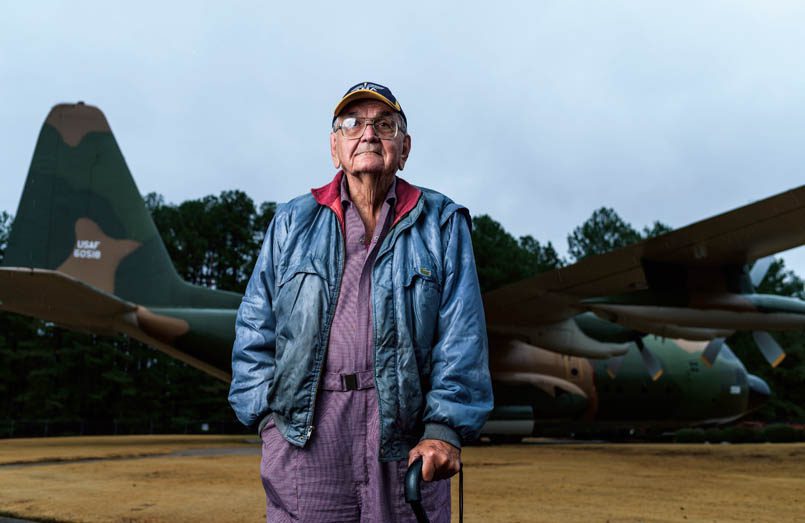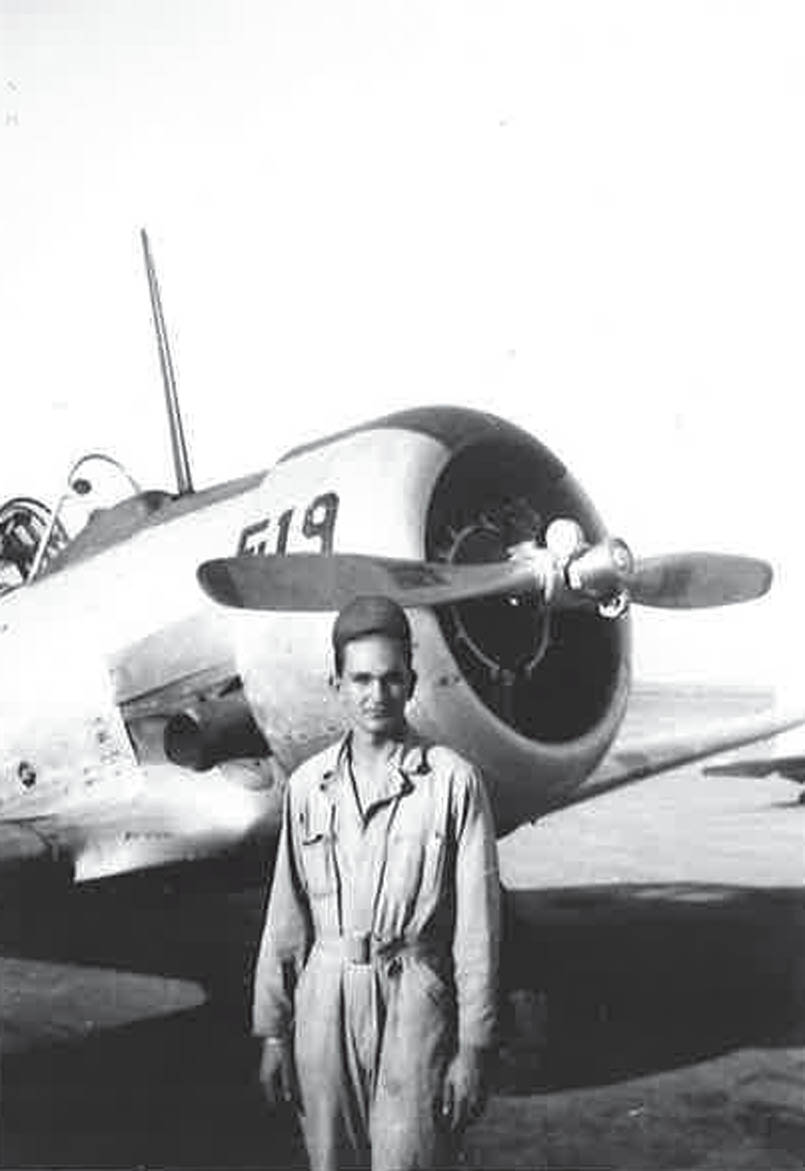26 Dec 2019 ‘An obsession’: Flying a big part of veteran’s life

Frank Osborne turned 94 in November, but he vividly remembers the day nearly 80 years ago when he knew his life changed forever.
“I was cultivating corn on the northeast 40 (acres) in ‘39 or ‘40, and two airplanes from Fort Sill, Okla., flew over,” he recalled. “They were painted blue and yellow, and they came over real low.
“I looked at them — I was sitting on a cultivator between two ornery old mules, and I decided that’s what I wanted to do. Everything from then on was geared toward that.”
From his teen years on a dirt farm “on the edge of the dust bowl in Oklahoma” to enlisting in the Army Air Force during World War II, through a 22-year active military career and 22 more years with the Veterans Administration, and more than 55 years — and counting — as a charter member of the Mid-Arkansas Radio Control Society, flying has been a big part of the Jacksonville man’s life.
“It’s just been a passion since I can remember,” Osborne said. “Even when I was a pre-teen, I would take old lumber and make airplanes out of it. I learned how to carve a propeller. It’s just been in my blood the whole time.
“It’s an obsession, I guess you’d say.”
On Dec. 8, 1941— the day after the Japanese bombed Pearl Harbor, leading to the United States’ entry into WWII — Osborne and a buddy decided to try to enlist, even though they were just 15.
“We didn’t think they’d let us in, but we hitchhiked 10 miles to the recruiting office, which was in the post office,” he remembered. “When we got there, there were four lines four-deep around the post office with people trying to enlist. It was moving slowly, and we decided they wouldn’t take us anyway, so we went on back to school.”
With his eye toward his future, Osborne took several correspondence courses on such topics as aeronautics and navigation that helped him graduate from high school in Verden, Okla., in three years. He enlisted in the Army Air Force on 4-4-44.
“I spent the first year-and-a-half, two years waiting to go to pilot training,” he remembered. “It was kind of late in the war, and they had more pilots than they knew what to do with. I saw a notice that they were looking for B-29 flight engineers, and I saw that as a way to get to fly, so I applied and was accepted.”
After graduating from pre-flight school, B-29 mechanic school and flight training in late 1945 — after the end of the war — Osborne was commissioned a second lieutenant and sent to Guam in early ‘46, shortly after marrying his high school sweetheart, Imogene, “the prettiest girl in school,” he said. They were married 58 years when she died. They had two children — David, who lived in Morrilton before he died several years ago, and Darlene, who lives in Lewisville, Texas. Imogene joined him on Guam for nearly a year, one of the “third boatload of wives to get to Guam after WWII.”
The B-29 was a new, long-range plane that could fly from Guam to Japan and back, Osborne said, with the engineer essentially in charge of cruise control.
“That was the first plane where the flight engineer had a position,” he said, pointing to duties that included control of engines, pressurization and gas flow to each engine as well as moving gas from control tanks to regular tanks. “The engineer had a regular seat where most of the engineers on other planes didn’t. They were glorified gunners.”
Besides the engineer and pilot, he said the B-29 crew also included a bombardier, co-pilot, navigator, radio operator, central fire control (gunner), two side gunners, tail gunner and, in later versions, a radar operator.
He joked that the pilot was “usually reading a magazine because he had the autopilot on.”
But the Oklahoma boy loved it.
“As long as I could fly, that was a childhood dream,” he said.
His 22 years of active duty included the major conflicts of WWII, Korea and Vietnam, but he never got to a combat zone.
“In Korea, they needed B-29 flight engineers, and friends around me would go and come back in six months with 20 missions and medals, and they never did call me,” he said. “I looked on it as a blessing at the time, but now I wish I would’ve gone over and done something.
“Of course, I might’ve been killed.”
After returning from Guam, he spent time on B-17s and flew military transports all over Europe and North Africa, still as a flight engineer. He remembered during the Cold War transporting big loads — tanks and road graders, among other items.

“One time we were going to a little base in Greenland, and we hauled 30 great big telephone poles,” Osborne remembered. “That was quite an escapade. The airplane was heated, and all the creosote melted out of the poles. When we landed in Greenland, it was a mess.
“It was about 30 below (zero) when we landed, and I asked the guy who was unloading the poles to clean it up, do the best you can. We came back from eating, the plane was spotless. It took them about 10 minutes to clean it because all the creosote froze and they just scraped it out.”
Osborne came to the Little Rock Air Force Base as a navigator bombardier on B-47s in February 1959 and retired from active duty in 1966.
After retiring on Saturday as a major, he went to work as a civilian in office equipment sales on Monday.
“I was a poor salesman, and I finally got a job with the Veterans Administration,” he said.
His 22 years with the VA included six months in Vietnam as a benefits counselor, an irony he finds amusing after he never saw conflict during his 22 years of active service.
While he said his only regret from his military career is that he didn’t make it through pilot training, he has made up for it ever since, with more than 10,000 hours of flying time. “I did a little flight training when I was a kid,” he remembered. “I managed to buy an old cow for $5, sold it for $80 and put that money into flight training. I soloed when I was 16 and had about 20 flying hours when I got in.
“Then there were aero clubs throughout the military, and I flew there just for fun and built up time. When I came here, I went to work and got all my commercial, instrument, and flight instructor licenses. I owned a couple of airplanes along the way, and my wife and I flew all over the country with them.”
Osborne was an independent flight instructor and gave up flying only after he had bypass surgery in 2001, although he continued to do flight checks until his instructor license expired.
And he still isn’t done with his hobby.
Osborne is one of two remaining charter members of the Mid-Arkansas Radio Control Society, which meets several times a week to fly model planes via radio control. He said the group began in 1963 and incorporated in ‘65.
“I won my first model airplane contest when I was 11 or 12, and I’ve been doing it ever since,” he said. “I’ve progressed. At first I couldn’t afford anything, but I’d usually get one or two for Christmas. Later on when I got paid I got a gas engine, and then later I got into the radio control thing.
“The first radio outfit I built out of plans and a magazine. It was semi-successful. Sometimes it worked and sometimes it didn’t.”
He said he had two or three that he’d built, but that the process had evolved over the years.
“You don’t build; you assemble,” he said. “I had assembled a couple of others like one I ordered, and just for fun I timed myself. From the time it came to the front door, it took me 40 minutes to get it ready to fly. All you needed was one crescent wrench and a cross-point screwdriver. Thirteen screws held it all together.”
Now married to Susanne, whom he worked with at the VA (“I was her supervisor,” he said. “Now the roles are reversed.”), Osborne joins other retirees to fly at least a couple of mornings a week.
“We have anywhere from three or four to 15 or 20 of us assemble on any given day,” he said. “We limit it to five people in the air at one time. With the old guys, if you’ve got two or three in the air, that’s a whole bunch. I usually fly twice, and on a real good day, I’ll get three in.”
His planes now are electric- and battery-powered.
“You usually drain the battery pretty fast, anywhere from five to 10 or 12 minutes,” he said. “We gather about 7 a.m. and hang it all up at 11 and all go somewhere and have a meal. It’s a lot of camaraderie.”
Looking back over his life and career, he marveled at the gumption of his “Greatest Generation.”
“They were young people, and we thought we were immortal,” Osborne said. “In Europe when 30 percent of the airplanes that went out on a raid were shot down, it was hard to believe that somebody would get on an airplane voluntarily and go.
“I used to fly with a fellow who flew B-17s in Europe and had 175 missions. I always told him he had a death wish. But they just had no qualms about going out and putting their life on the line.”
A few days before the interview for this story, someone hit Osborne’s truck from behind and totaled it. After flying early the next morning, he was headed truck shopping.
“I’ve got a truck spotted, and I’m going to go buy it,” he told a reporter.
May we all be so vital at 94.
- Fits like a glove - December 2, 2025
- Petit Jean: The place for partnerships - December 1, 2025
- Youth of the Month: Emalee Jack Goforth and Bailey Fournier - November 4, 2025








